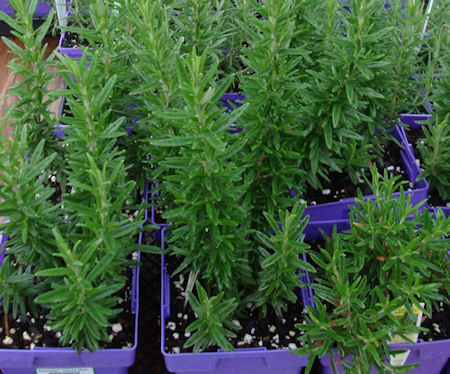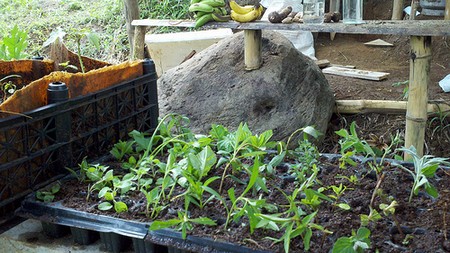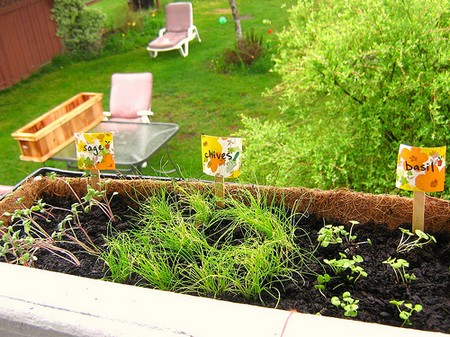How you propagate a herb will be determined by the type or plant it is. It may be an annual, which completes its life cycle in one growing season; a biennial, which flowers and dies in the second growing season after germination; a perennial, which lives for at least three seasons; or a shrub, a woody-stemmed plant usually branching from near the base. Annuals and biennials are often grown from seed. Perennials and shrubs can be grown from seed, though this is usually a multi-year process. It is often easier to buy plants, or to propagate by one of the other methods described below. Usually one type of propagation is likely to be more advantageous than others. For example, true tarragon is sterile and cannot be grown from seed, so it needs to be propagated by division. For the easiest methods of propagation for individual herbs.
Depending on the size of your herb garden, the type of plant, and how easy it is to grow, it may be sensible to buy plants. If, for instance, you are gardening in a window box or in pots, or if you do not require large numbers of plants, it may well be easiest to purchase pre-grown herbs. You may also prefer to purchase plants if you require a herb that is hard to propagate – for instance, parsley can be difficult to germinate – or if you do not have the right conditions in which to grow tender plants from seed. Buy annuals and perennials in the spring and early summer. Hardy containerized shrubs and perennials may be bought and planted at any time of the growing season. They will tend to do better — and need less constant watering – if you avoid planting them at the height of summer; spring and autumn are best.
If you are unable to find unusual herbs at your local garden centre, you can order plants or seeds in late winter or early spring from specialty garden catalogues, either through the mail or over the Internet.
Division
Perennial herbs can be propagated by division – that is, by dividing clumps in early autumn or in the spring into pieces, each with a root system and one or more shoots. You can do this to make more plants for other parts of the garden, to give plants to friends, or to make smaller clumps, felt to their own devices some perennial herbs increase in size until they takeover an area. Dividing improves plant vigour. Overgrown chimps of perennials often die out in the centre and have reduced flowering, which is a sign of the need to divide and replant.
To divide, water if the soil around the plant is dry, then loosen the soil and ease the clump up with a garden fork. Some clumps can then be teased apart by hand; for tougher rootstocks use two garden forks.
Mints and bee balm have long rhizomes: underground stems that spread out, putting down roots, and from which aerial stems shoot up. To propagate these herbs, ease up lengths of rhizomes with a fork and plant in pots or in the garden with the rhizomes half buried.
Layering
Some perennial herbs, such as pennyroyal, send out long scrambling stems overground that may sprout roots where they touch the soil. With these, you can encourage rooting by layering: weighting or pegging down these stems with a stone or a loop of wire pushed into the soil. Most small shrubby herbs, such as thyme and winter savory, can be encouraged to root in a similar fashion, despite their woody stems. With plants such as sage and lavender, which have longer stems, you can mound up soil over a leggy stem to stimulate new root growth. Once roots have formed, cut the connecting stem to create a new plant.
Cuttings
Taking a cutting is simply a matter of cutting a length of stem and giving it the conditions needed to encourage root growth. With soft-stemmed plants such as tarragon or hops, take stem cuttings from new growth in early summer, cutting a young shoot just below a leaf about 5—10 cm (2—4 inches) from the tip.
With woody shrubs such as rosemary or bay, take semi-ripe cuttings in late summer once new stems have hardened slightly, cutting a shoot just below a leaf about 10-15 cm (4-6 inches) from the tip.
When you are dealing wirh roses, you need to wait until mid autumn, when you can take fully ripened hardwood cuttings. Make the cut at the junction between the current seasons growth and the growth of previous seasons, and trim to 1 5 cm (6 inch) lengths.
Dip the cuttings in rooting hormone powder (available at garden centres), and put them into pots of a commercial soilless mix, ideally one that has been designed for cuttings. Place them in a cool greenhouse or cold frame, or cover with a transparent plastic bag to stop them from drying out, and keep at about 18-2PC (65-70°F). When the cuttings have rooted — indicated by growth at the tips — transplant into 10 cm (4 inch) pots and harden off before transplanting into the garden.
A few herbs, such as the mints, root easily in water. Cut a stem 15-20 cm long (6-8 inches) at any time during the growing season, drop it into a glass of water (remove any leaves below the water level), and stand it on a sunny windowsill at 18-21°C (65-70°F).
Root cuttings are an easy way to propagate comfrey and horseradish. Take sections of root about 5 – 10 cm (2 – 4 inches) long in the autumn, and simply plant them directly where you want them in the garden. They should root by the following spring.
Categories
Advertisements
Recent Articles
 How to Understand Bed Sizes – A Small Guide
How to Understand Bed Sizes – A Small Guide How to Select Some Must Have Kitchen Accessories
How to Select Some Must Have Kitchen Accessories Best Way to Change a Car Tire
Best Way to Change a Car Tire Best Way to Write an Affirmation
Best Way to Write an Affirmation Best Way to Take Charge of Your Financial Life
Best Way to Take Charge of Your Financial Life Best Way to Survive a Party When You Don’t Know Anyone
Best Way to Survive a Party When You Don’t Know Anyone Best Way to Stop Self Sabotaging Yourself
Best Way to Stop Self Sabotaging Yourself Best Way to Start Journal Writing
Best Way to Start Journal Writing Best Way to Speak with a Powerful Voice
Best Way to Speak with a Powerful Voice Best Way to Simplify Your Life
Best Way to Simplify Your Life Best Way to Respond to a Put-Down
Best Way to Respond to a Put-Down Best Way to Reduce Acne Breakouts
Best Way to Reduce Acne Breakouts Best Way to Recover from Dining Disasters
Best Way to Recover from Dining Disasters Best Way to Quit Your Job Gracefully
Best Way to Quit Your Job Gracefully Best Way to Make Your Own Website
Best Way to Make Your Own Website




Leave a Reply